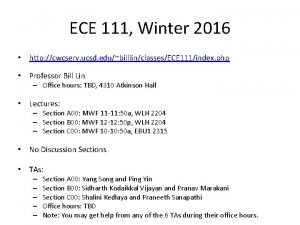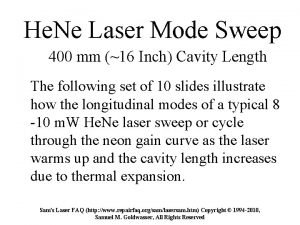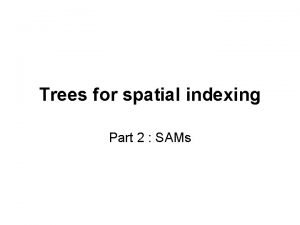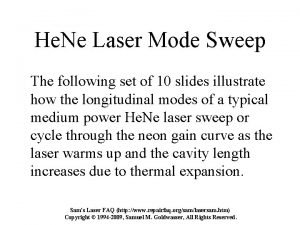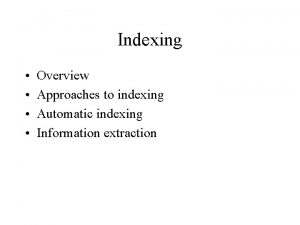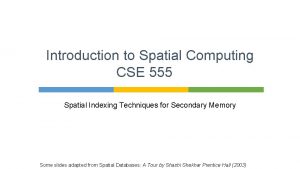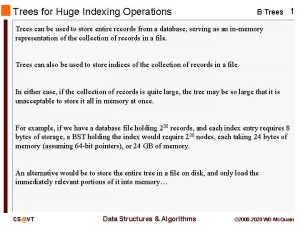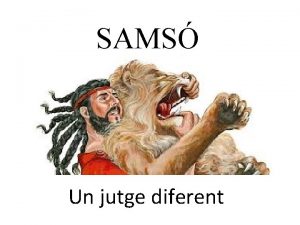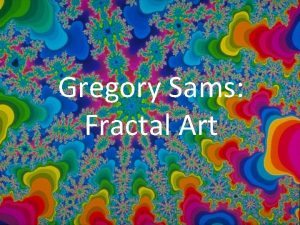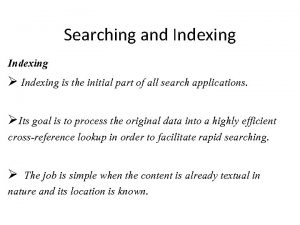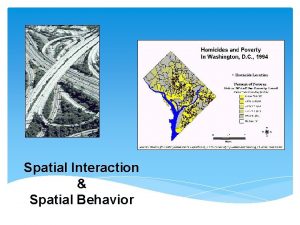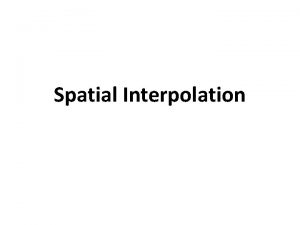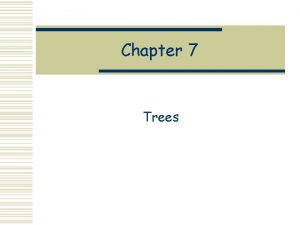Trees for spatial indexing Part 2 SAMs SAMs
























- Slides: 24

Trees for spatial indexing Part 2 : SAMs

SAMs R-Tree R*-Tree X TV

Answering question • The Kd-Trie, is similar to kd-tree. In the article it was used for kd-tree. • The split-axis isn’t in the middle, but is choosen is the median point. • Because, we work with points, we have no problem is separating the elements.

UB-Tree range queries • Algorithm is : • Find all region who intersects q – IF this region is a page, all objects that intersects q is in the answer. – After that we search for the last subcube in this region and we search the brother, and if it intersects q we make the same loop on it. – After that we look the father of B and search again.

R-Tree • Special B+-Tree for spatial indexing. • The performance of the R*-Tree is decreasing with the dimensionality. • R-tree access method is prohibitively slow for dimensions higher than 5.

Problems of (R-Tree based) Index Structures • Because it has been shown that with the increasing of the dimensionality we have also more overlap. • Overlap is intuitively when for some point queries, we have multiple paths to search.

Definition of overlap • Intuitively, overlap is the pourcentage of the volume that is covered by more than one directory hyperrectangle. • This intuitive definition of overlap is directly correlated to the query performance. • Because it implies multiple paths.

Definition of the overlap (2) • Overlap = ||( Ui, j, i≠j Ri ∩ Rj )|| / ||( Ui Ri )|| • We add all the intersection of the MBR in volume and we divide it by the union of all the MBR in volume. • But overlap in highly populated areas is much more critical than overlap in low population. • Weighted. Overlap = |{ p|p Ui, j, i≠j Ri ∩ Rj )}| / |(p|p Ui Ri )|

1 1 Overlap = (¼)/(2) = 1/8 = 12, 5 % Weighted. Overlap = (2)/(6) = 1/3 = 33 %

Overlap / Weighted. Overlap • Depending the kind of data the measurement can be different. • If we have uniformed distributed data points, we can use the overlap measure • In the case of real data, when can have clustering, so the weighted. Overlap is more accurate.

X-Tree • Avoid overlap in the directory. • X-Tree hybrid of a linear array-like and a hierarchical R-Tree-like directory. • In low dimensions the most efficient organization of the directory is hierarchical organization. • For high dimensionality a linear organization is more efficient.

X-Tree • In the X-Tree we have 3 types of nodes : data nodes, normal directory, and supernodes. • The supernodes avoid splits in directory, so it’s more faster to search. • Not the same as R*-Tree with larger blocks, because it creates larger blocks only if necessary.

X-Tree Supernode Normal directory Data nodes

Creation of supernodes • They are only created if there is no other possibility to avoid overlap during insertion.

TV-Tree (Telescopic-Vector tree) • The basis of the tv-tree is to use dynamically contracting and extending feature vectors. ( Like in classification )

TV-Tree • • A m-contraction of x, is a sequence of Amx where Am is a contraction matrix. A natural Am is (10… 0) (010… 0) ( …. ) ( 0 …. 0 1)

Multiple shapes • We can use for example a sphere, because it’s only a center and a radius r. Represents the set of points with euclidean distance ≤ r. • ~the euclidean distance is a special case of the Lp metrics with p=2. • For L 1 metric (manhattan distance) it defines a diamond shape. • The TV-tree is working with any Lp-sphere.

Tv-Tree principle • So the TV treats the attributs asymmetrically favoring the first few features over the rest. • TV-Tree can use any type of MBR (minimum bounding region), rectangle, cube, sphere etc. • TV-Tree can use any Lp-Sphere

TV-Tree node structure • Each node is represents the MBR of all it’s descendents ( say an Lp-sphere ). • Each region is represented by a center which is a telescopic-vector and a radius. • So we talk about TMBR.

TV-1 -Tree example

TV-2 -Tree example

TMBR Act. Dim : y Act. Dim : z Act. Dim : x, y Act. Dim : x

What is the best number of active dimensions ? • They find out that the best number of active dimensions was two

TV-Tree conclusion • We accept overlap, so also multiple path to search. • Branch choosen for new point is done with the following criteria :
 Contoh pengindeksan manual
Contoh pengindeksan manual Pre-coordinate indexing
Pre-coordinate indexing Spatial data vs non spatial data
Spatial data vs non spatial data Indexing head parts
Indexing head parts Substance abuse monitoring system
Substance abuse monitoring system Ucsd flying sams
Ucsd flying sams Web sams
Web sams Mcfrs sams login
Mcfrs sams login Sam's sweep
Sam's sweep Sams slp
Sams slp French toast sticks sams
French toast sticks sams Sams ub
Sams ub Slidetodoc.com
Slidetodoc.com Web sams
Web sams Samsscore
Samsscore Terry sams
Terry sams Answer the
Answer the Onkel sams barbershop
Onkel sams barbershop 04.05 uncle sams toolbox-honors
04.05 uncle sams toolbox-honors Department of education revised curriculum 2020
Department of education revised curriculum 2020 Dr richard sams
Dr richard sams Web sams
Web sams Sam's sweep
Sam's sweep Vem räknas som jude
Vem räknas som jude Claes martinsson
Claes martinsson





